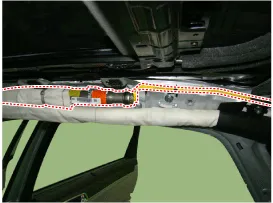Hyundai Genesis (DH): Airbag Module / Curtain Airbag (CAB) Module Repair procedures
| Removal |
| 1. |
Disconnect the battery negative cable and wait for at least 3 minutes before beginning work. |
| 2. |
Remove the roof trim assembly.
(Refer to Body - "Roof Trim Assembly") |
| 3. |
Disconnect the curtain airbag harness connector.
|
| 4. |
After loosening the mounting bolts remove the curtain airbag.
|
| Installation |
| 1. |
Turn the ignition switch OFF. |
| 2. |
Disconnect the battery negative cable and wait for at least three minutes. |
| 3. |
Tighten the curtain airbag mounting bolts.
|
| 4. |
Connect the curtain airbag connector. |
| 5. |
Install the roof trim assembly.
(Refer to Body - "Roof Trim Assembly") |
| 6. |
Reconnect the battery negative cable. |
| 7. |
After installing the curtain airbag (CAB), confirm proper system operation:
Turn the ignition switch ON; the SRS indicator light should turn on for about six seconds and then go off. |
Description The Knee Airbag (KAB) is installed inside the crash pad lower panel and protects the driver in the event of a frontal crash. The SRSCM determines if and when to deploy the KAB.
Other information:
Hyundai Genesis (DH) 2013-2016 Service Manual: Auto Head Lamp Leveling Unit Troubleshooting
Inspection with GDS Initialization and diagnosis sequence by using GDS equipment. The following is the summarized A/S procedure. NoProcedure1Park the vehicle on level ground2Tire check3IGN1 ON4Head lamp Low Beam ON5Connection with diagnostic tool6Initial command by diagnostic tool7Clear DTC Code8IGN1 OFF > ON9Re- Connection with diagnostic t
Hyundai Genesis (DH) 2013-2016 Service Manual: CO2 Sensor Description and Operation
Description This system maintains the density of carbon dioxide constantly in vehicle interior by measuring the amount of carbon dioxide to increase the comfortableness and the fuel consumption rate when air conditioning system is operating.
Categories
- Manuals Home
- Hyundai Genesis Owners Manual
- Hyundai Genesis Service Manual
- Purge Control Solenoid Valve (PCSV) Schematic Diagrams
- Components and Components Location
- Body (Interior and Exterior)
- New on site
- Most important about car



